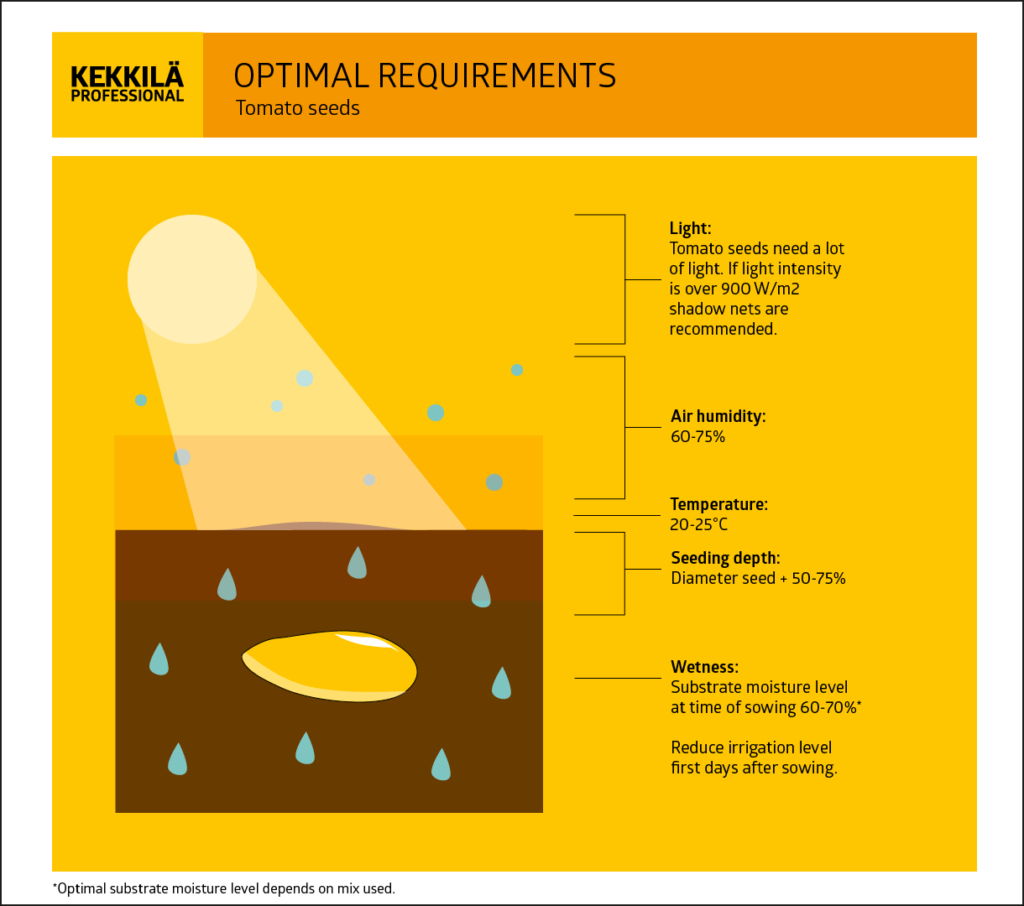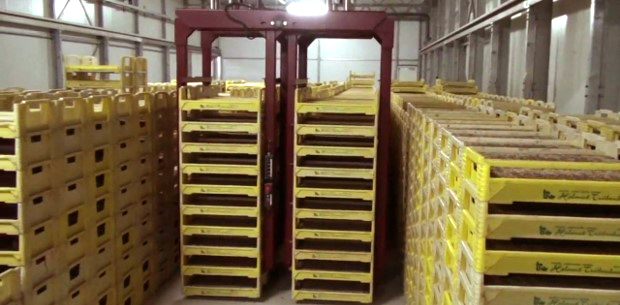Tomato Propagation in easy steps
With this article we want to make tomato propagation easier. Among other things we explain how to optimally prepare the substrate before sowing, what circumstances are required for successful germination and how to take care of the germinating seeds.
So, let’s talk tomato propagation. In this article you’ll find all you need to know about sowing tomatoes for optimal germination.
Prepare your substrate before growing for optimal tomato propagation
Before you can start sowing the tomato seeds, you need to prepare the substrate.
Compressed bales of substrates need to be loosened up before filling the trays. Make sure to add water to the substrate when loosening it and avoid mixing or milling. Follow the steps below for the best result:
- Add water to the substrate. In general the moisture content of the substrate at the time of sowing should be around 60-70% . This may vary per substrate mixture.
- Fill the trays with substrate under clean and hygienic conditions. Make sure you do this away from weeds, dirt, organic waste, herbicides and other potentially harmful substances.
- Clean and disinfect the tools, materials and space used properly after filling the trays.
- Make sure to not put the seeding trays directly on the ground during the germination phase. Ideally there should be at least 15cm between the ground and the trays. Otherwise contamination could occur, which threatens tomato propagation.
- When using a seeding machine, ensure that it is fine tuned properly according to manufacturer recommendations to avoid fluctuations in seeding.
- Allow the air in and “ventilate” the substrate. It is extremely important to allow oxygen into the substrate to prepare ideal conditions for rooting to take place. Remember substrate bales are wrapped in plastic for a while until they reach you as a grower. Oxygen levels are low and drop gradually during transportation due to natural microbal activity within the substrates. Would you like to learn more about microbes in peat? Read this article.
Tomato seed requirements
Tomato seeds, as little as they are, have specific requirements that need to be met for optimal germination and young plant growth. The infographic below shows what to take into account during the germination phase.
It’s imporant to avoid too wet confitions, to keep an eye on the light intensity and temperature and to make sure seeds are placed at the right depth. If the tomato seed is placed too deep, the seedling will have to work harder to reach the surface of the substrate. That way it looses the food until it germinates to the outside. If it’s placed too shallow, it will get weak because the roots won’t have proper support. Meet the requirements below and you tomato propagation will be as successful as ever!

Sowing tomato seeds
As shown above, tomato seeds need light to germinate. Cover the seeds lightly with a fitting cover layer. The cover layer should not be wet. Apply the layer by sprinkling the dry material directly over the seeds, following the seeding depth calculation as shown in the infographic above. Sprinkle it loosly over the tray and brush off any excess. Next, lightly spray a little water over the layer. This top layer prevents the seed from drying out and absorbs water from the plug.
The composition of the cover mix may vary depending on grower preferences, climate conditions, seeding machine, tomato variety etcetra. In general the mix should be made of a medium-coarse material that provides well aerated conditions. We recommend to mix 50% of peat with 50% of sand, perlite or vermiculite.
Using a Germination Room for tomato propagation
In order to promote even germination of the seeds, it is recommended to store the trays in a dark and cooler room for the initial phase of germination. This helps the seeds to start the enzyme process inside, which speeds up germination.
- Air humidity: 80-90%
- Temperature: at least 5-6°C lower than in the greenhouse/nursery.
- Moderately moist substrate: irrigation after sowing is sufficient. Moisture level should be 60-65%.
- Time period: Place seed trays in Germination Room immediately after sowing. Leave them there for up to 48 hours (depending on the variety).

Irrigation & water quality
While water quality is rarely checked by growers, it is one of the most important factors for young plant production. The table below shows the requirements for the water quality for optimal tomato propagation.
| Optimal pH-range | 5.5 – 6.0 |
| Optimal EC-level | < 1.0 dS/m |
| Water temperature | Ideally 25 °C (20 – 26 °C is still okay) Can affect growth strongly if temperate us wrong |
| Optimal Ca | 4-6 meq/L |
| Optimal Mg | 1-2 meq/L |
| Optimal Na | < 3 meq/L and < 0.75 meq/L for germination |
| Bicarbonates | 3 meq/L |
Irrigation needs to be reduced during the first 2-3 days from sowing. This way the substrate gets time to settle into the trays propperly. Next to that the seedlings are sensitive when they start to germinate and they need to be handled with ease. When 70-80% of the seeds has germinated and are showing green cotyledons regular irrigation can start.
The choice of shower head/sprinkler head is very important. Water drop size needs to be as fine as possible (fine rain 0.2 – 0.6 mm). This will reduce stress for small seedlings until they are stronger and able to handle more.
Fertigation through irrigation
Calcium Nitrate should be added to the first irrigation ( 1 g CaNO3 / Liter water). After germination the seedlings may be irrigated with NPK (N:K 1:1) or Calcium Nitrate (2g CaNO3 / Liter water).
If you follow all these rules and requirements the propagation of your tomato’s should go smoothly. Would you like to know more about Kekkilä Professional products for tomato propagation, or do you need some more guidance? Don’t hesitate to contact our distributor in your region.

